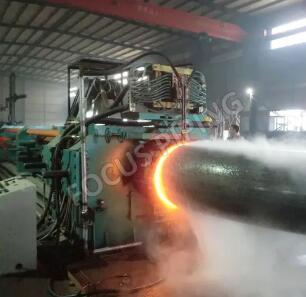Hot Induction Bending (HIB) and Cold Induction Bending (CIB) are two common methods of pipe bending used in a variety of industries, including oil and gas, petrochemical, and water supply. These two methods have their own advantages and disadvantages, and provide a basis for consideration in choosing the right method for your project. The following will compare and contrast HIB and CIB, and help you decide which one is more suitable for your project.
Heat Induced Bending (HIB)
Heat induction elbows involve the use of heat to bend the pipe to the desired angle. The process involves heating the pipe with an induction coil until it reaches the desired temperature, then bending it using a bending machine. HIBs are used in a variety of industries including oil and gas, petrochemicals, and power generation. Key benefits of HIB include:
Consistent Quality: HIBs provide consistent bend angles and radii, resulting in a high-quality finished product.
Fewer welds: HIBs can be bent to a radius of up to 5D, reducing the number of welds required, making the pipe more reliable and leak-proof.
Customizable: HIBs can be customized to meet the specific needs of any project, including different diameters and angles.

Increased Efficiency: HIBs provide smooth, gradual bends that reduce pressure drop and ensure consistent flow, increasing pipeline efficiency.
Cold Induction Bending (CIB)
Cold induction bending involves bending pipe without using heat. The process involves cold bending the pipe using a bender, which applies pressure to the pipe until the desired angle is achieved. CIBs are commonly used in water supply and infrastructure projects. Key benefits of CIB include:
No heat required: CIBs do not require the use of heat, which makes them more environmentally friendly and safer to use.
Cost-effective: CIBs are less expensive than HIBs, making them ideal for projects on tight budgets.
Ease of Transport: CIBs are more compact and easier to transport than HIBs, making them ideal for projects with limited space.
Durable: CIBs are durable and can withstand harsh environmental conditions, making them ideal for infrastructure projects.
Which is better for your project?
The decision to use a HIB or a CIB depends on several factors, including project requirements, budget, and environmental concerns.
Project Requirements: The HIB is ideal for projects requiring high precision and flexibility, such as oil and gas and petrochemical projects. The HIB can be customized to meet the specific needs of any project, making it ideal for complex projects requiring high precision. CIBs are ideal for projects that require a more direct bend, such as water supply and infrastructure projects.
Budget: CIBs are less expensive than HIBs, making them ideal for projects on a tight budget. However, the long-term cost savings possible with HIBs, such as increased pipeline efficiency and reduced maintenance costs, must be considered.
Environmental concerns: HIBs require the use of heat, which can have a significant impact on the environment. If the environment is a priority, CIBs may be a better choice because they don't use heat and are more environmentally friendly.
In summary, the decision whether to use a HIB or a CIB depends on several factors, including project requirements, budget, and environmental concerns. These two methods have their own advantages and disadvantages, providing a basis for consideration in choosing the right method for your project.
Previous: Steel Adaptor for Cup Wheel/Core Drill/Dimond Tool
Next: None.
Copyright:@2020-2021
Comments Please sign in or sign up to post.
0
0 of 500 characters used